Normally, the car engine is hidden under the bonnet. Why should you take the trouble of cleaning it? After all, in the pure mechanical or electric sense you run the risk of doing more damage than good. Nevertheless there are several valid reasons for giving your engine an occasional cleaning. It is important to follow certain steps to attain the desired result whilst preventing it from ending in a repair. Read in this manual, how to safely make your engine shine again.
| 1. Errors of engine cleaning |
| 2. Engine cleaning at home |
| 3. Engine cleaning in the wash box |
| 4. Engine cleaning for profis |
| 5. Engine cleaning by dry-ice blasting |
 Advantages of a clean engine
Advantages of a clean engine
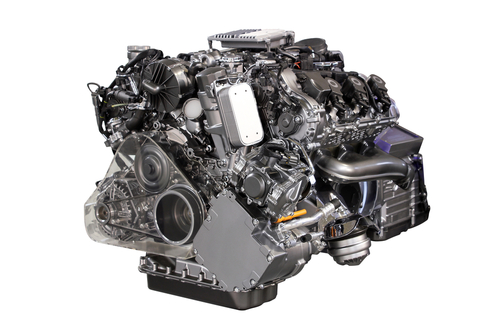 A clean engine has several great advantages. These are:
A clean engine has several great advantages. These are:
|
– a better appearance |
A clean appearance boosts the ego of the car owner. More importantly, it enhances the selling value of the car. With a shining, clean engine the car generally looks better cared for. Evidently, a thorough polishing as well as an interior cleaning should be part of the sales preparation.
![]() It is often said that a “cleaned engine has something to hide” as all traces of leakage have been washed away, but this is nonsense. But it’s just the opposite: only in a clean engine it is easier to check for leakage of fuel or coolant after a test run.
It is often said that a “cleaned engine has something to hide” as all traces of leakage have been washed away, but this is nonsense. But it’s just the opposite: only in a clean engine it is easier to check for leakage of fuel or coolant after a test run.
Ultimately, working on a clean engine is much more convenient. You no longer look like a coal shoveler after replacing a generator. You could just as well conduct repairs in a wedding costume.
 Errors of engine cleaning
Errors of engine cleaning
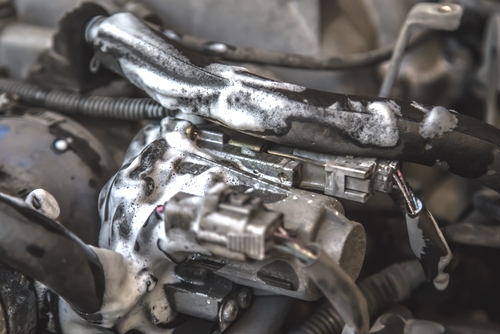 Incorrect cleaning of the engine can disable the transmission and in the worst case destroy it. Furthermore, legal stipulations must be considered. Otherwise you run the risk of a substantial fine and a serious disruption of relationships with neighbours and home owners.
Incorrect cleaning of the engine can disable the transmission and in the worst case destroy it. Furthermore, legal stipulations must be considered. Otherwise you run the risk of a substantial fine and a serious disruption of relationships with neighbours and home owners.
Watching images and videos of an engine wash, you often notice a high-pressure cleaner is applied to the engine. In essence this is correct. On the other hand, indiscriminate “kärchering” will certainly disable your engine. The water injected under high pressure penetrates every plug connection and loosens everything which is not tightly screwed on. This could easily lead to electric and electronic malfunctions, possibly causing permanent defects.
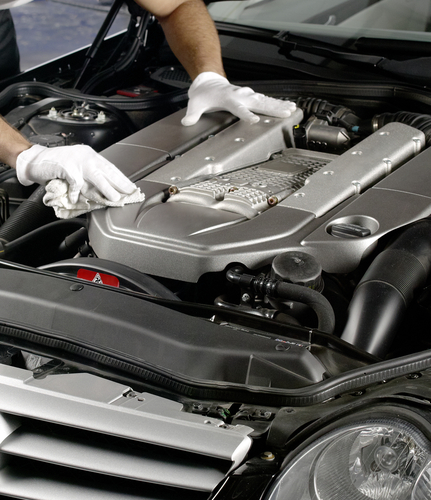 Attempts to cool down an overheated engine with a cold water jet can have serious consequences: metal parts might warp and no longer fit together afterwards. This causes frictions between the separate parts of the car but also internally. In the worst case you risk causing a crack the engine bay.
Attempts to cool down an overheated engine with a cold water jet can have serious consequences: metal parts might warp and no longer fit together afterwards. This causes frictions between the separate parts of the car but also internally. In the worst case you risk causing a crack the engine bay.
Cleaning the engine washes oil and coolant from the transmission. The polluted water should not reach the sewage system. This is subject to a fine and will provoke the anger of neighbours and home owners.
Simply in the wash box?
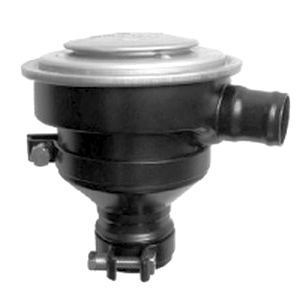 In view of the mentioned environmental considerations, going to the car wash could be a good alternative. However, it must be made certain if engine cleaning is allowed at the wash station. The car-wash operator should have a so-called oil separator installed. If it is not available, only cleaning the bodywork and the car interior is allowed. Otherwise, operators could face a heavy fine. They are apt to react angrily when someone cleans his engine at their station when this is not permitted. Further admission could be refused.
In view of the mentioned environmental considerations, going to the car wash could be a good alternative. However, it must be made certain if engine cleaning is allowed at the wash station. The car-wash operator should have a so-called oil separator installed. If it is not available, only cleaning the bodywork and the car interior is allowed. Otherwise, operators could face a heavy fine. They are apt to react angrily when someone cleans his engine at their station when this is not permitted. Further admission could be refused.
Three methods for a clean engine
For a safe and legal cleaning of the car engine, three options are available:
|
– Manually at home |
1. Engine cleaning at home
![]() It should be clear in advance: only a limited cleaning of the engine is possible with DIY solutions. More than a superficial cleaning should not be attempted at home. The law doesn’t allow it and there is a high risk of causing damage.
It should be clear in advance: only a limited cleaning of the engine is possible with DIY solutions. More than a superficial cleaning should not be attempted at home. The law doesn’t allow it and there is a high risk of causing damage.
To clean your engine at home you need to have a garage. When opting for a DIY cleaning, pollution of the underground should be avoided at all cost. Therefore, prior to the cleaning, put a large piece of cardboard or an old carpet under the engine bay.
For a DIY cleaning you need:
– an effective detergent
– rags, paint brush and ordinary brush
– appropriate working clothes
– brake cleaner
– a well-ventilated workshop
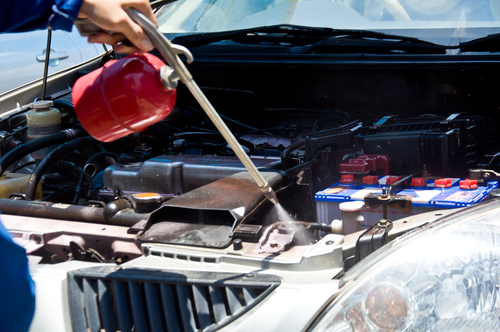 A heavy-duty degreasing detergent is the most effective solution for DIY engine cleaning. Special detergents such as oven cleaner or stain remover could come in useful. In most cases, a special engine cleaner is not necessary. Products such as ProWIN and Cillit-Bang are recommended.
A heavy-duty degreasing detergent is the most effective solution for DIY engine cleaning. Special detergents such as oven cleaner or stain remover could come in useful. In most cases, a special engine cleaner is not necessary. Products such as ProWIN and Cillit-Bang are recommended.
Prior to cleaning the engine needs to be completely cooled down and a large piece of cardboard or carpet should be put under the engine bay. It is essential for the cardboard or carpet to be absorbing as to prevent anything leaking away. The engine must be switched off during cleaning in view of the risk of injury.
Now, the engine is sprayed abundantly with detergent. Allow it to soak in. Subsequently clean the engine from top to bottom with brush and rags.
Persistent stains should be sprayed with brake cleaner. Brake cleaner is a very effective solvent of dirt. Its main advantage is its quick evaporation. The solution is highly inflammable. Therefore do not smoke during application and ensure that the workshop is adequately ventilated. After total evaporation of the brake cleaner the engine is as clean as it can get with a DIY engine wash. All rags as well as the mat (carpet or cardboard) should be disposed of.
2. Engine cleaning in the wash box
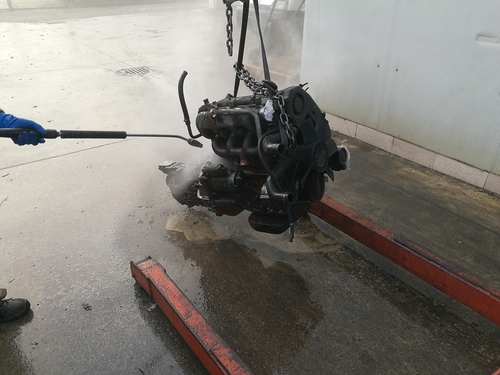 DIY engine cleaning is a dirty job. Certain legal risks are involved and the result is seldom fully satisfactory. Visiting a car wash is evident. As said, it is important to find a service provider allowing engine cleaning.
DIY engine cleaning is a dirty job. Certain legal risks are involved and the result is seldom fully satisfactory. Visiting a car wash is evident. As said, it is important to find a service provider allowing engine cleaning.
When cleaning the engine at the car wash, the engine is also sprayed with engine cleaner, oven cleaner or a very effective degreaser on soap basis in advance. Brake cleaner is not necessary in this instance. Subsequently the high-pressure cleaner is applied with the car engine running. Take care not to point the jet
– at the distributor cap
– at the fuse box
– at the plug connections
– at the control unit.
Some knowledge of the engine layout is required to prevent errors while using the high-pressure cleaner. The engine is kept running to enable it to dry.
If the engine stops or can’t be started, possibly the distributor cap got wet. Generally, it can be removed, cleaned with absorbing kitchen paper and installed again.
Cleaning the engine at the car wash is a quick, though slightly risky solution. Also, you only reach the top part of the engine. The ideal solution for really causing the engine to shine, is having it cleaned professionally.
3. Only the professional can do this
A service provider can do the following things for you:
– Professional and complete engine wash
– Provide warranty
– Use of the most modern technologies.
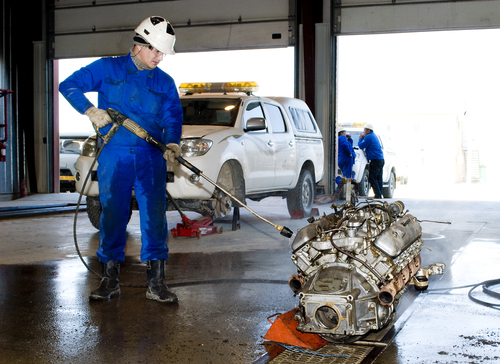 A service provider has the right expertise for a correct and safe cleaning of the engine. He knows exactly what to observe and is generally able to prevent any damage to the electric system. Furthermore a garage can clean the bottom part of the engine as well, which is next to impossible when cleaning the engine at home or at the car wash. If any damage occurs, the garage is insured, which doesn’t leave you with repair costs.
A service provider has the right expertise for a correct and safe cleaning of the engine. He knows exactly what to observe and is generally able to prevent any damage to the electric system. Furthermore a garage can clean the bottom part of the engine as well, which is next to impossible when cleaning the engine at home or at the car wash. If any damage occurs, the garage is insured, which doesn’t leave you with repair costs.
Today, the most advanced cleaning technologies are only available to garages who can afford them. Most service providers still work with the high-pressure cleaner. Recently, a modern technology made itself available, which is not only very safe, but so effective that the engine looks like new: dry- ice blasting.
For perfectionists: engine cleaning by dry-ice blasting
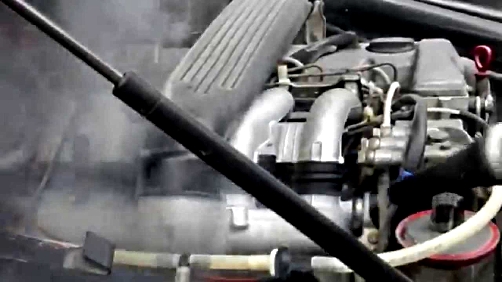 Dry ice is frozen carbon dioxide, processed into small pellets and blasted against the soiled spot under high pressure. Upon impact on the surface the pellets evaporate immediately, scouring off all loose dirt particles. The result is an engine so clean, you would almost think you possess a new car. Dry-ice cleaning has its price: where a conventional cleaning doesn’t cost over 15 – 20 euro (£ 14- 24), a modern professional cleaning could easily cost twice that amount. However, the result justifies the cost. Furthermore, waterless dry-ice cleaning is very safe. Damage to the electric system can be almost completely ruled out.
Dry ice is frozen carbon dioxide, processed into small pellets and blasted against the soiled spot under high pressure. Upon impact on the surface the pellets evaporate immediately, scouring off all loose dirt particles. The result is an engine so clean, you would almost think you possess a new car. Dry-ice cleaning has its price: where a conventional cleaning doesn’t cost over 15 – 20 euro (£ 14- 24), a modern professional cleaning could easily cost twice that amount. However, the result justifies the cost. Furthermore, waterless dry-ice cleaning is very safe. Damage to the electric system can be almost completely ruled out.
Foto: risteski goce, MoonAngelEyes, Menzl Guenter, buffaloboy2513, AlexKZ, robypangy, Polifoto / shutterstock.com

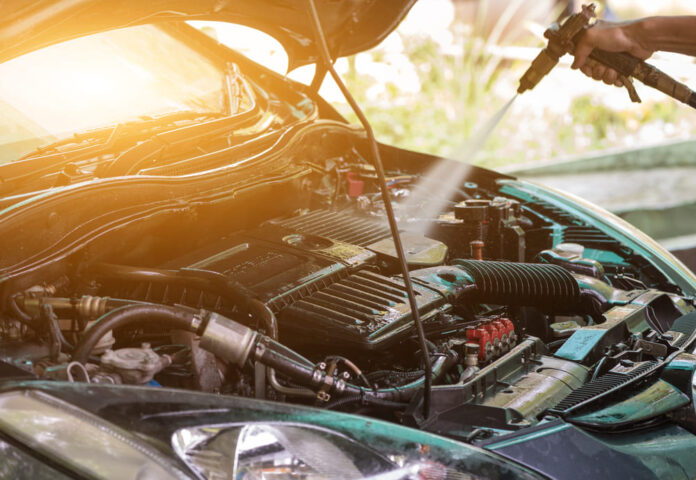


 (7 votes, average: 3.86 out of 5)
(7 votes, average: 3.86 out of 5)







